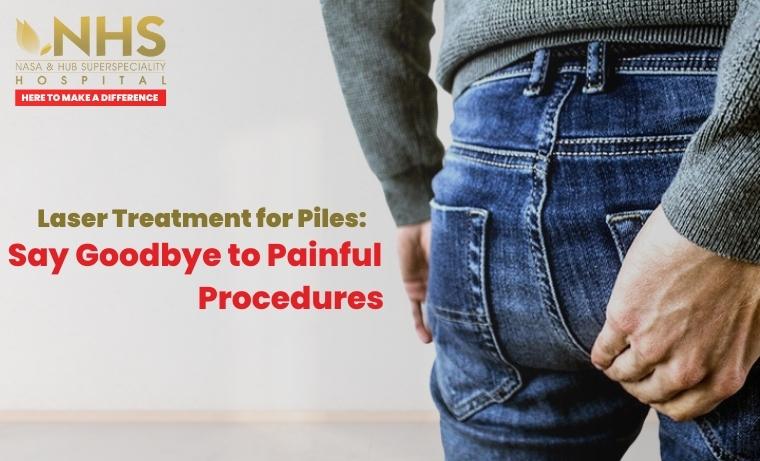
Laser Treatment for Piles: Say Goodbye to Painful Procedures
Piles, also known as haemorrhoids, are a common and troublesome condition that affects many individuals. They occur when the blood vessels in the rectal area become swollen and inflamed, leading to discomfort, pain, and sometimes bleeding. Whether caused by straining during bowel movements, pregnancy, obesity, or a sedentary lifestyle, piles can significantly impact one's quality of life. However, advancements in medical technology have brought about a revolutionary solution: laser treatment for piles. This minimally invasive procedure offers precise targeting, minimal pain, quick recovery, and fewer complications, promising relief and a brighter future for those suffering from piles.
Understanding Piles
Piles, also known as haemorrhoids, occur when the blood vessels in the anal Canal become swollen and inflamed, leading to discomfort, pain, and even bleeding. Few of the causative factors for piles are:
- straining during bowel movements
- pregnancy
- obesity
- sedentary lifestyle
Fortunately, medical advancements have brought about an innovative and efficient solution: laser treatment for piles.
Stages Of Piles
The stages of piles, or haemorrhoids, can be summarised as follows:
- First-degree piles: Mild symptoms, including occasional discomfort, itching, and minimal bleeding during bowel movements.
- Second-degree piles: Haemorrhoids enlarge and may prolapse during bowel movements, but they typically retract on their own.
- Third-degree piles: More frequent prolapse, often requiring manual repositioning.
- Fourth-degree piles: Haemorrhoids become permanently prolapsed and cannot be manually repositioned. Severe pain, bleeding, and complications are common.
The Laser Solution: A Game-Changer in Piles Treatment
Laser treatment for piles has emerged as a revolutionary alternative to traditional methods. It offers a minimally invasive approach that targets the root cause of the problem without the need for surgical incisions. The procedure involves the use of a highly focused laser beam, which effectively reduces the size of the haemorrhoids, reduce the blood supply and cause shrinkage.
One of the key advantages of laser treatment is its precision. The laser beam can accurately target the affected blood vessels, sealing them off and causing minimal damage to surrounding tissues. This precision helps to minimise post-operative pain and discomfort, leading to a faster recovery compared to conventional surgical procedures.
Understanding the stages of piles is crucial for accurate diagnosis and determining the appropriate treatment approach for effective relief and management of symptoms.
Benefits of Laser Treatment for Piles
- Minimal Pain and Discomfort: Laser treatment causes less pain during and after the procedure compared to traditional methods. The precision of the laser beam reduces damage to surrounding tissues, resulting in a quicker healing process and less postoperative discomfort.
- Quick Recovery: Unlike conventional surgical procedures, laser treatment for piles allows for a faster recovery time. Patients can typically resume their daily activities within a few days after the procedure, reducing the disruption to their normal routine.
- Fewer Complications: Laser treatment significantly reduces the risk of complications compared to traditional surgical methods. The precise nature of the procedure minimises the chances of infection, scarring, and other adverse effects, ensuring a safer treatment option for patients also, it prevents injury to sphincter muscle around anal opening so as to avoid long term complications of incontinence, unlike the open surgery.
- Outpatient Procedure: Laser treatment for piles is often performed on an outpatient basis, meaning patients can return home on the same day. This eliminates the need for an extended hospital stay and allows individuals to recover in the comfort of their own homes.
Is Laser Treatment Suitable for Everyone?
While laser treatment for piles offers numerous benefits, it may not be suitable for everyone. Individuals with severe cases of piles may require alternative treatment options. It is crucial to consult with a qualified healthcare professional who can assess your condition and recommend the most appropriate course of action.
Embracing a Pain-Free Future with Laser Treatment for Piles
Laser treatment for piles can significantly improve the quality of life for individuals who undergo the procedure. Here are some ways in which quality of life improves after laser treatment:
- Reduced Pain and Discomfort
- Improved Bowel Movements
- Decreased Bleeding
- Faster Recovery
- Enhanced Emotional Well-being
- Minimised Recurrence
Thanks to advancements in medical technology, individuals suffering from piles can now bid farewell to painful and invasive procedures. Laser treatment provides a game-changing solution that offers precision, minimal discomfort, quick recovery, and fewer complications. As this innovative approach becomes more widely available, individuals can look forward to a future free from the burdens of piles, allowing them to regain control over their lives.
